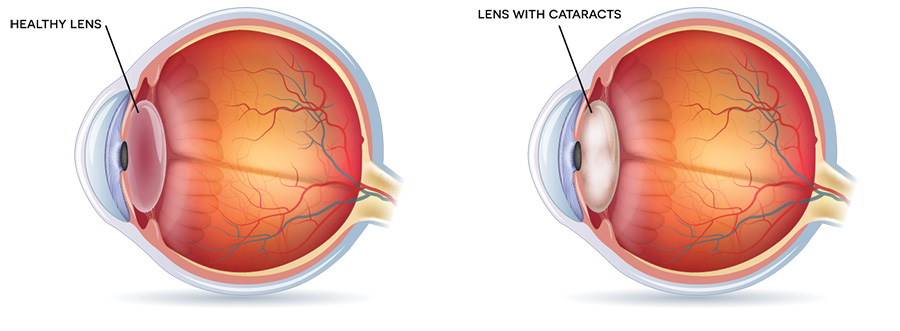Cataract Surgery

What is a Cataract?
A cataract is a clouding in the typically clear lens of an eye, people tend to think it is a film covering the outside of the eye. Lenses are located inside of the eye, behind the iris, and are responsible for focusing light for clear vision. Cloudiness occurs as the lens ages, as well as sometimes as a side effect of medication. Consequently, blurred vision occurs due to lens clouding.
Even though cataracts usually affect both eyes, they can sometimes affect just one eye. It is not uncommon for one cataract to have a greater degree of cloudiness, causing poorer vision in that eye. A cataract typically develops when someone gets older, the clouding of the lens changes with age in varying degrees for every individual. Cataracts are more likely to occur if you have a family history.
How are Cataracts Detected?
An eye care professional can diagnose cataracts through a comprehensive eye exam. Additionally, there are other reasons for worsening vision. During the exam, you can evaluate visual nerve diseases like glaucoma and retinal disorders like macular degeneration. It may not be possible to restore perfect vision after cataract surgery if another disease also occurs.

How are Cataracts Treated?
Over time, cataracts can progress to a point where operation is necessary for better sight. In order to perform necessary or desired activities, cataract surgery is necessary if you are no longer able to see clearly. In cases of impaired driving, reading, or recreation activities with cataracts, surgery is reasonable. The treatment of cataracts is not possible with medication.
Do you think that you might be suffering from cataracts? Take our FREE online cataract Self-test and see if you’re a good candidate for cataract surgery.
Cataract Surgery
Cataract surgery is now done on an outpatient basis and typically only requires a two-three-hour stay. Typically, the surgery takes between ten to twenty minutes and is painless. During surgery, most anxiety is relieved with a mild sedative. Using ultrasound, the cataract is removed with a very small incision made in a bloodless area of the eye. Insertion of the foldable lens implant is accomplished through the same small incision as before. In this case, the lens is implanted behind the pupil, where there was a cataract. As a result, the wound is secure and seals itself on its own. For the first day, a seal is applied to the eye, and then a shield is to be worn at night. It is possible to resume regular activities as soon as possible. After surgery, patients are given eyedrops every day for a month to reduce infection risk and speed healing.
Eyesight Before & After Cataract Surgery
What are the risks of cataract surgery?
Even if you have a successful surgery, there is still a risk of vision problems. Generally, there is a 4-5% chance of complications occurring. Hence, 95% of patients report some (or significant) improvement in their vision.
How soon can I get back to normal activities after cataract surgery?
Following surgery, some eye doctors advise you not to lift heavy objects or engage in strenuous activity for three to four weeks. The majority of eye doctors do not restrict your movement in any way, except maybe not to swim for a few days. You will have to wait a few weeks to determine exactly which glasses will work best to supplement your distance vision and/or reading vision, but you will be able to function virtually as normal during that time.

